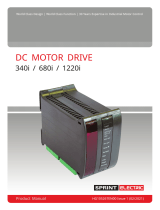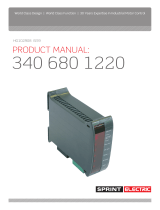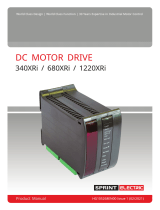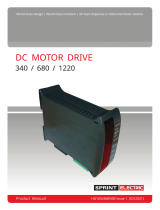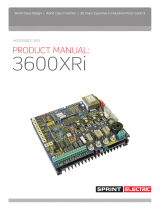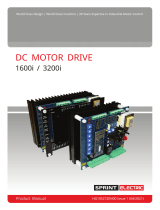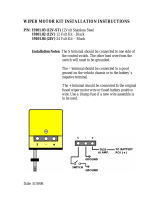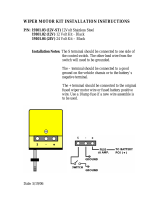Page is loading ...

World Class Design | World Class Function | 30 Years Expertise In Industrial Motor Control
HG102938 ISS15
PRODUCT MANUAL:
340i 680i 1220i

Model 340i / 680i / 1220i DC drive product manual 1
EXTERNAL CONTROLS
INSTALLATION
340i / 680i / 1220i
DC Motor Controller
Product Manual
This drive is an isolated single direction
speed controller for shunt wound or permanent magnet motors. It utilises speed feedback from the armature
voltage (Avf), or from a shaft mounted tachogenerator. It incorporates a fully controlled thyristor bridge with a
current loop to protect the drive and motor. It can be used in speed or current control modes. The drive can
motor forward and will regenerate for reverse rotation by an external force. Please obtain expert help if you are
not qualified to install this equipment. Make safety a priority.
This component is hazardous. (All specifications in this document are nominal).
340i 0.55KW (0.5 HP) at 180 Volts DC, 3.4 Amps
680i 0.75KW (1.0 HP) at 180 Volts DC, 6.8 Amps
1220i 1.80KW (2.0 HP) at 180 Volts DC, 12.2 Amps
(The KW / HP ratings are typical motor ratings at or below the available terminal rating of Watts= Varm x Iarm)
Versions that work from 60V / 30V AC supply are also available.
340i / LV60, 680i / LV60, 1220i / LV60. For motors rated up to 48V DC
Armature: 200 Volts DC. or 50V DC for LV60 models
Models 340i / 680i / 1220i 3.4/ 6.8/ 12.2 Amps.
Field: Volts DC=0.9 x AC supply volts. 1 Amp Max.
(0.45 x AC for field connected to F- and N). 1 Amp Max.
110V AC or 240V AC +/-10%, 50–60 Hz.
30V AC or 60V AC +/-10%, 50-60Hz for LV60 models.
Speed range 0–100%. (motor dependant)
Load Regulation typically 0.2% tach, 2% Arm Volts.
Presets accessible under lift up cover.
Clockwise rotation for linear increase in parameter.
Relay driver Threshold (Level) +/-(0.5% to 105%). (+/-10.5V) Symmetrical about zero.
Maximum Speed (Max spd) 40V-200V span with Spd x 2 switch. (Avf/Tach fb volts)
LV60 models have an Avf range 10 - 50V.
Minimum Speed (Min spd) 0 to 30% of maximum speed. (With 10K external pot).
Up Ramp (Ramp) 20 to 1 seconds up ramp rate. (For 0 to +10V)
Down Ramp (Ramp) 20 to 1 seconds down ramp rate (For +10 to 0V)
Stability (Stab) Gain 1 to 10
Maximum Current (I max) 0 to 100% current limit.
IR compensation (IR comp) 0 to 25%
Speed setpoint from external 10K Ohms pot.
External RUN contact for electronic STOP/START.
Built in functions are +/- channel with pushbutton control inputs, and
relay driver with variable threshold. There is a pot kit available with graduated dial and knob.
Speed loop: Full P+I armature voltage or tach feedback.
Current loop: Full P+I isolated current feedback.
Use correctly rated cable minimum 600V AC,
1.5 times armature current.
DOC# HG102938 iss 15, 29/04/13
MAXIMUM OUTPUT
AC SUPPLY INPUT
SPEED RANGE
USER ADJUSTMENTS
CONTROL ACTION
POWER RATING

2 Model 340i / 680i / 1220i DC drive product manual
PRESET POT settings
FUSING REQUIREMENT
MECHANICAL
To avoid damage, ensure the supply selection jumper on the drive
matches the incoming supply. 110V or 240V AC.
For models with LV60 suffix 30V AC or 60V AC.
Semi-conductor fuse parts.
20A fuse (BUSSMANN FWH020A6F) CH00620A
Fuseholder 6 X 32mm CP102071
DIN rail clip for fuseholder FE101969
Suitable for use on a circuit capable of delivering not more than 5000A RMS symmetrical amperes when protected
by an aR class fuse.
WARNING Protection must be provided by a correctly rated semi-conductor fuse, fitted upstream of the
drive. The fuse must have an I
2
t rating of less than 150 A
2
s.
To satisfy UL requirements for branch circuit short-circuit protection the fuse must be as specified above.
Control signals are isolated from the supply, and the unit may be
connected to other isolated instruments.
The unit is designed to clip onto a DIN rail. Avoid vibration and ambient
temperatures outside –10 and +40C. Protect the unit from pollutants.
Ensure there is an adequate supply of clean cool air to ventilate the unit
and the enclosure it is mounted in. (Dissipation in Watts = 5 x Armature Amps).
Foot mounted motors must be level and secure. Protect motors from
ingress of foreign matter during installation. Ensure accurate alignment
of motor shaft with couplings. Do not hammer pulleys or couplings onto
the motor shaft.
Before running motor, complete the following check list. (Warning isolate the supply first).
1) Correct insulation between all motor windings and earth. ( prior to testing)
2) Check inside connection box for foreign objects, damaged terminals etc.
3) Check that brushes are in good condition, correctly seated and free to move in brush boxes.
Check correct action of brush springs.
4) Motor vents must be freed of any obstruction or protective covers prior to running.
Please note this drive does not provide motor over-temperature protection. If required, equip your motor
with thermal sensor device that can remove the supply when activated by over-temperature.
Set the I max (Max Current) preset to approximately match the motor
armature rating. Fully clockwise is 100% drive rating.
(340i 3.4A, 680i 6.8A, 1220i 12.2A). Fully anticlockwise is 0%. E. g. for a
340i unit a midway setting is 50% i.e. 1.7A. More accurate setting requires a suitable current meter in series with
the armature. Set the Stab preset midway. (Clockwise rotation of the stab preset increases gain, excessive
rotation may lead to instability).
Set all the other presets anticlockwise to start off with. (Note LV60 models avf range 10-50V )
The preferred strategy for initial commissioning is in armature voltage feedback mode described as follows. Set
Avf/Tach switch ON (left) for armature voltage feedback (Avf) and Spd x 2 switch OFF (right) for 40V max
feedback. For systems utilising tach feedback, remove the terminal 11 tach connection and temporarily make
wire end safe until later.
Check that the Power lamp lights. Close the run contact.
Increase the external speed pot slowly to maximum.
The motor should slowly ramp up to around 40V on the motor armature. (10V for LV60 models). Now set the
correct 100% armature voltage and hence speed by using the Spd x 2 switch (ON (left) for speed X 2) and the Max
spd preset (Clockwise to increase). Note, if you change the Spd x 2 switch position whilst running, the speed will
undergo an immediate step change.
The up / down ramps can now be set between 20 and 1 seconds, and the
Min spd adjusted up to 30%.
(Note, down ramp becomes up ramp for negative input).
POWER ON
RAMP and MIN SPEED
CONTROL SIGNALS
MOTOR
AC SUPPLY

Model 340i / 680i / 1220i DC drive product manual 3
IR COMP
TACH FEEDBACK
Speed droop on heavy loads may occur when armature voltage feedback
is used. This is compensated for by clockwise rotation of IR comp.
Excessive rotation may lead to instability.
Note, IR comp is not used with tach feedback, leave preset anticlockwise.
The tach feedback signal on terminal 11 must be negative with respect
to terminal 10 COMMON for a positive speed demand input.
Whilst still in AVF mode and running at 100% speed, measure the tach
volts on the wire intended for T11. (Warning, possible high voltage). This is the tach full speed voltage. Make a
note of it to assist in selecting the speed range. Stop the motor and turn off the supply.
Set Avf/tach switch OFF (right) to disconnect AVf and then re-connect the tach wire to T11. By using the tach
voltage reading just obtained, you can adjust the full speed with the Spd x 2 switch and/or Max spd preset.
With Spd x 2 switch OFF (right) the Max spd range = 40 to 100V.
With Spd x 2 switch ON (left) the Max spd range = 80 to 200V
To do this re-start and adjust Max spd as required within the selected range, suggest starting anticlockwise.
1 +10V output. 10mA max. (Use a 10K Ohm pot for external speed reference).
2 MIN SPEED. (Bottom end of external pot. 5K Ohms preset to common).
3 IP. Speed input. 0 to +/-10V speed input from pot wiper. 47K internal pull down.
4 OP+/-. +/-10.5V range. Input from T6. Invert with pushbutton input T8 open. Non-invert with pushbutton
input T7 open. 10mA max.
5 COM. Common. (0 Volts)
6 IP+/-. Input to pushbutton controlled +/- signal channel. OP on T4. 50K Ohms impedance for invert mode,
10M input impedance in non-invert mode. The operating mode is controlled by PB+ on T7 and PB- on T8.
Note. This channel can invert input signals in the range +/-10.5V. It can also buffer (i.e. non-invert) signals
in the range 0V to +10.5V. (It cannot buffer negative signals. If you try to buffer a negative signal the
output will be positive).
Note. If using a high resistance external pot for positive signals e.g. greater than 20KOhms, then this
channel can be used to buffer it using the non-invert mode.
7 PB+ Pushbutton input. 47K Ohm pull up to +12V. Connect to T5 COM. When opened it latches T4 to buffer
(non-invert) mode for positive T6 input signals, provided T8 PB- is connected to T5 COM.
8 PB- Pushbutton input. 47K Ohm pull up to +12V. Connect to T5 COM. When opened it latches T4 to (invert)
mode for positive and negative T6 input signals.
Note. The PB- function will operate when T7 PB+ is either open, or connected to T5 COM.
See truth table below for T7 and T8 operation. See terminal 6 IP+/- for notes.
PB+ Terminal 7
PB- Terminal 8
Input T6 to output T4 mode
Closed to Common
Open circuit
Invert (+/-10.5V range)
Closed to Common
Closed to Common
Remains in prevailing mode.
Powers up in invert mode.
Open circuit
Closed to Common
Non-invert (0 to +10.5V range)
Open circuit
Open circuit
Invert (+/-10.5V range)
a) Hence if PB+ Terminal 7 remains open then a switch on PB- Terminal 8 can be
used to change modes.
b) If both PB+ Terminal 7 and PB- Terminal 8 remain open then the invert mode is established.
c) If both PB+ Terminal 7 and PB- Terminal 8 are connected to common then the desired mode can be
established by momentarily opening PB+ Terminal 7 for non-invert, or PB- Terminal 8 for invert mode.
The mode remains latched when the common connection is re-established.
9 RUN. Internal 12K pull up to +12V. Open to stop, close to COMMON to run. WARNING. RUN is an electronic
inhibit function. The field remains energised, and all power terminals ‘live’. RUN must not be relied
on to ensure the machine is stationary during hazardous operations. Remove the power source to the
system.
Opening T9 RUN will cause immediate drive inhibit and hence if the motor is rotating at the time it will
coast to zero speed.
TERMINAL LISTING

4 Model 340i / 680i / 1220i DC drive product manual
Flywheel diode,
47K resistor and
47nF capacitor
LM324
+12V
Output
termina
l
This diode allows
relay outputs to
be OR'd together
if desired,
10 COM. Common. (0 Volts)
11 TACH input. The tach must be opposite polarity to speed input. 1.5 MOhms.
Will accept full scale feedback voltages between 40V-200V using Spd x 2 switch with Max spd preset.
12 RLOP. Relay driver. +10.5V active high. Flywheel diode to COM.
Note. The output is current limited. When in current limit, the output voltage achieved, depends on the
resistance of the load multiplied by the available current limit at that voltage, according to the table
below.
Output
voltage
Typical
current lim
Typical load
resistance
10.5V
1mA
Greater than
10K Ohms
10.0V
10 mA
1000 Ohms
9.5V
15 mA
633 Ohms
9.0V
20 mA
450 Ohms
8.5V
25mA
340 Ohms
8.0V
30mA
267 Ohms
When driving relays, ensure the coil operating range is
suitable. E. g. a 12V relay with a coil operating range of 80-110%
will energise at voltages of 9.6V and above (80% of 12V).
Hence it must have coil resistance greater than 633 Ohms for the output to be capable of
achieving the desired voltage. A suitable UL approved relay is Hongfa type HF41F/9.
13 RLIP. Relay driver input. Accepts 0 to +/- 10.5V signal inputs. The threshold to activate the relay driver is
symmetrical around zero, and set by the RELAY preset between +/- 0.05V and +/-10.5V. When the T13
input exceeds the positive or negative threshold, then the T12 RELAY DRIVER OUTPUT is turned ON. Typical
uses include zero speed detector, zero current detector, stall detector etc..
The input will accept any output provided on other control terminals. 50K Ohm pull down to common.
14 OVLD. Overload. This output goes high (+10.5V) if the current demand exceeds 110% and the stall timer
starts timing. Flywheel diode to COM. See T12 RLOP for details of the output drive capability and
configuration.
Note. OVLD stays high if the overload subsequently results in a stall trip condition.
LM324
+12V
T12
RLO
Flywheel diode,
47K resistor and
47nF capacitor
LM324
+12V
-
+
-
+
invert
10.5V
T13
RLIP
Level preset range
0.5% to 105%
50k Pull
down

Model 340i / 680i / 1220i DC drive product manual 5
ALARMS
JOGGING
The stall timer will allow 150% motor current for approximately 30 seconds before tripping. The overload
integrator can tolerate 50% overload x 30 secs = 1500 units.
(A 50% overload is 150% of motor current set on Imax)
Stall timer Operation
Minimum available overload time prior to trip = 1500 / Overload % in seconds
Overload time examples 125% Imax current for 60 secs (1500 / 25 =60)
112.5% Imax current for 120 secs. (1500 / 12.5 =120)
Note. The stall timer is actuated by current demand exceeding 110% when the desired speed remains
unsatisfied. E.g. Excess load, insufficient supply volts, loss of feedback, saturated feedback, insufficient
torque, jammed shaft. This allows the protection to be more comprehensive than overcurrent alone.
15 TRIP. This output goes high (+10.5V) and latches high when the stall timer has timed out (in which case T14
OVLD will also be high) OR if the fan alarm has operated (in which case T14 OVLD will be low). Flywheel
diode to COM. See T12 RLOP for details of the output drive capability and configuration.
WARNING. TRIP is an electronic armature current inhibit function. The field output remains energised, and
all power terminals ‘live’. TRIP must not be relied on to ensure the machine is stationary during hazardous
operations. The motor FIELD output remains energised with TRIP active please beware of overheating the
motor when stopped. (Does not apply to permanent magnet motors).
16 ROP. Ramp output. 0 to +/-10V output for 0 to +/-10V input. 1K Ohm output impedance.
17 DEM. Demand output. 0 to -/+10V output for 0 to +/-100% speed demand. 1K Ohm output impedance.
Represents the inverted total speed demand.
18 SOP. Speed output. 0 to +5V output for 0 to +100% speed feedback. 1K Ohm output impedance.
NOTE: Prior to LA issue 11 (see side of terminal block), the output at this terminal was 0 to +10V.
19 IOP. Current output. 0 to +5V output for 0 to +100% armature current. Maximum output +7.5V for +150%
current. 1K Ohm output impedance.
20 SPD. Auxiliary speed input. Added to main input. Input impedance 100K Ohm.
0 to +/-10V input for 0 to +/-100% speed demand, direct input fast response.
21 TRQ. Torque input. 100K Ohms pull up to +12V.
0 to +5V input for 0 to +/-100% current demand. This input acts as a clamp on the current demand
produced by the speed loop. Also if the speed loop current demand falls below the input clamp level then
the speed loop has priority. For the clamp to operate, the speed loop current demand must be arranged to
exceed the clamp level by ensuring the speed demand is high enough.
A+ Motor armature + Form Factor typically 1.5. (Load dependant)
A- Motor armature -
F- Motor Field – (No connection required for permanent magnet motors).
F+ Motor Field +(For half wave field volts 0.45 X AC, connect field to F- and N).
N AC supply. 110V AC or 240V AC +/-10%, 50–60 Hz. (30/60VAC for type LV60)
L AC supply. 110V AC or 240V AC +/-10%, 50–60 Hz. (30/60VAC for type LV60)
Terminal tightening torques A+ A- F- F+ N L 4.4in lb - 0.50Nm
Terminals 1 to 21 2.2in lb - 0.25Nm
Models 680i and 1220i use an internal fan for cooling. The Alarm lamp
will come ON and the drive will electronically shut down if the internal
fan fails. (T15 TRIP alarm output available).
WARNING. This alarm is an electronic armature current inhibit function. The field output remains energised,
and all power terminals ‘live’ hence it must not be relied on to ensure the machine is stationary during
hazardous operations. The motor FIELD output remains energised, please beware of overheating the motor
when stopped. (Does not apply to permanent magnet motors).
For frequent stopping or jogging it is recommended to use T9 RUN
input. When using a mains contactor, connect a spare Normally Open
contact from the contactor in series with T9 RUN input.

6 Model 340i / 680i / 1220i DC drive product manual
BLOCK DIAGRAM
Showing wiring for ON OFF switch with ramp or coast to stop
The +10V ref is connected to the speed pot by a switch giving a ramp to zero when opened.
Note. The AVF/tach select switch must be set, and the appropriate speed scale range selected for the max
feedback volts, depending on the source of speed feedback.
If a tachogenerator is used the polarity on T11 must be negative with respect to COM T10.
A protective earth connection is made to terminal 10.
Acw
10K
Pot
Cw
Run or ramp to
Stop switch.
RUN switch. Close
to COMMON. Open
for coast to STOP.
Optional TACH
for speed
feedback.
Optional speed
indicator. +5V =
100%
Optional current
indicator. +7V5 =
150%
Semi-
conductor
fuse.
2 pole AC
supply
switch
+10V
Min
IP
OP+/-
COM
IP+/-
PB+
PB-
RUN
COM
Tach
1
2
3
4
5
6
7
8
9
10
11
12
13
14
15
16
17
18
19
20
21
RLOP
RLIP
OVLD
TRIP
ROP
DEM
SOP
IOP
SPD
TRQ
L
N
F+
F -
A-
A+
Invert
Non-invert
OP IP
5
K
Up / Down Ramp
OP on T16. ROP
Speed P+I error
amplifier with
stability preset.
Output provides
current demand.
Arm Amps
Isolation
Amplifier.
IOP on T19
Max Current
Preset
Total speed
demand DEM
on T17 (-ve)
Speed Output
SOP on T18
Arm Volts
Isolation
Amplifier
X 2
30 Sec Stall timer
with logic outputs
TRIP on T15 and
Overload on T14
Current
Demand
Clamp.
0 - 5V on
T21 =
0 -100%
+12V
Centre zero comparator with window
threshold from +/-50mV to +/-10.5V
Goes high on T12 (0-10V. 10mA) if
+/- signal input T13 exceeds window.
+12V
.1
M
12
K
Current P+I error
amp with phase
angle controlled
anti-parallel
bridge.
340i/680i/1220i
AC 240V or 110V
Field coil
Armature.
For armatures
with a time
constant of
less than 5mS
a DC choke
must be wired
in series.
AC supply must be
semi-conductor fused.

Model 340i / 680i / 1220i DC drive product manual 7
EMC
Special consideration must be given to installations in member states of
the European Union regarding noise suppression and immunity. According
to IEC 1800-3 (EN61800-3) the drive units are classified as Basic Drive Modules (BDM) only for professional
assemblers and for the industrial environment. Although CE Marking is made against the EMC Directive,
application of EN 61800-3 means that no RF emission limits apply. The drive manufacturer is responsible for the
provision of installation guidelines. The resulting EMC behaviour is the responsibility of the manufacturer of the
system or installation. The units are also subject to the LOW VOLTAGE DIRECTIVE 73/23/EEC and are CE marked
accordingly.
Following the procedures outlined will normally be required for the drive system to comply with the European
regulations, some systems may require different measures. Installers must have a level of technical competence
to correctly install.
Power supply port
The power supply port is subject to alternative guidelines, as described below. Compliance with emissions limits
on this port may or may not be required depending on the environment. If required then compliance can be
achieved by fitting a separate filter unit, contact supplier for details.
EN61800-3 specifies 2 alternative operating environments. These are the domestic (1
st
environment) and
industrial (2
nd
environment). There are no limits specified for conducted or radiated emissions in the Industrial
environment, hence it is usual for the filter to be omitted in industrial systems.
Definition of an industrial environment: Includes all establishments other than those directly connected
to a low voltage power supply network which supplies buildings used for domestic purposes.
In order to meet mains conducted emissions limits on this port for the 1
st
environment, a separate filter is
required. Please refer to supplier for a suitable filter (EN 61800-3 restricted distribution, domestic environment).
Earthing and screening guidelines
A separate earth conductor is taken from the motor housing and is run adjacent to the drive conductors right up
to the main earth terminal in the enclosure. This conductor should not be grounded separately to any other earth
point.
The drive protective earth on Terminal 10 should be separately taken to the cabinet star earth point.
Motor drive and three-phase supply cables should be segregated from other cables in the cabinet, preferably by a
distance of at least 300mm. They can be screened or armoured, especially if they pass near other sensitive
apparatus, and the screening should be bonded to the motor housing and the point of entry of the cabinet using
360º gland techniques.
It is understood that the bonding of both ends of the screening and earth conductors may result in
significant earth current flow if the motors and control cabinet are in widely different locations, so that there
are large earth potential differences. In these circumstances it is recommended that a separate parallel earth
conductor (PEC), which may be a bonded metal conduit, is used alongside the drive cables to give a preferential
route for this current. See IEC 61000-5-2 for more detail. Installation in conformance with this standard is
regarded as good practice and will result in improved EMC of the whole system.
WARNING Safety earthing always takes precedence over EMC earthing.
Guidelines when using filters Filter Part number FRLN16.
1) The AC connections from the filter to the drive must be less than 0.3m or if longer correctly screened.
2) The AC filter and motor cable screen should connect directly to the metal of the cabinet.
3) Do not run filtered and unfiltered AC supply cables together.
4) The AC input filter has earth leakage currents. RCD devices may need to be set at 5% of rated current.
5) The AC supply filter must have a good earth connection to the enclosure back plane. Take care with painted
metal. Remove paint and ensure good connection.
T h e A C su p p ly filt er c o n tain s h ig h
v o lt ag e c ap ac it o rs a n d s h o u ld n o t b e
t o u c h ed f o r a p erio d o f 2 0 sec o n d s af t e r
t h e rem o v al o f th e A C su p p ly
T h e A C su p p ly f ilt ers m u st
n o t b e u sed o n su p p lies t h a t
are u n -b alan c ed o r f lo at w it h
res p ec t t o eart h
T h e d riv e an d A C f ilt er m u st o nly b e
u sed w ith a p erm a n e n t eart h
c o n n ec t io n . N o p lu g s/ so c k et s are
allo w ed in t h e A C s u p p ly
IM PO RT A N T S A FET Y W A RN IN G S

8 Model 340i / 680i / 1220i DC drive product manual
WARNINGS
The product is enclosed in a stylish DIN rail mounted enclosure with plug
in screw terminal connections.
Height
Width
Depth
340i
105
60
120
680i
105
70
120
1220i
105
70
120
Earthing A clean signal earth
Connection should be made to
Terminal 10 (Common). The motor
earth should be connected to the
earth in the system enclosure.
Health and safety at work. Electrical devices constitute a safety
hazard. It is the responsibility of the user to ensure compliance
with any acts or bylaws in force. Only skilled persons should install
this equipment. Sprint Electric Ltd does not accept any liability whatsoever for the installation, fitness for
purpose or application of its products. It is the users responsibility to ensure the unit is correctly used and
installed.
UL file E168302
MECHANICAL DETAILS
Max Speed
Min Speed
Up Ramp
Stability
Comparator
Level preset
IR Comp
Alarm lamp
Sw1 AVF
Sw2 Spd x 2
Max Current
Lift up cover
Stall lamp
Increasing brightness for
imminent trip.
Power ON lamp
Brighter for positive current.
Down Ramp
Supply
Select
Terminals
12 to 21
A+ A- F- F+ N L
Fan exhaust
For models
680i, 1220i
DIN rail
release catch
with bottom
rear access
slot. (Unplug
terminals to
gain access)
Terminals
1 to 11
Sprint Electric Limited, Arundel, UK
Tel. +44 (0)1243 558080
Fax. +44 (0)1243 558099
Email. info@sprint-electric.com
www.sprint-electric.com
Armature
Field
Basic single direction speed control with tach feedback
1 2 3 5 9 10 11 A+ A- F- F+
10K Pot
RUN
Tach
Earth

Find out more:
www.sprint-electric.com
Sprint Electric Ltd. Peregrine House, Ford Lane, Ford
Arundel, West Sussex, BN18 0DF United Kingdom
Tel: +44 (0)1243 558080
Fax: +44 (0)1243 558099
Email: [email protected]
/

